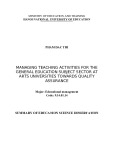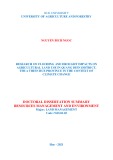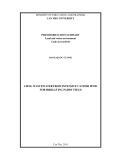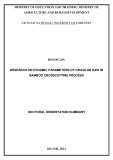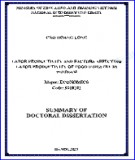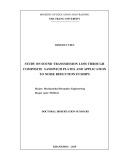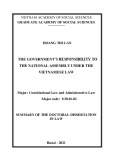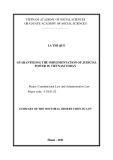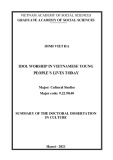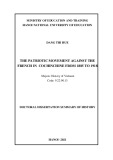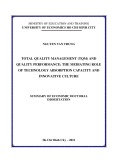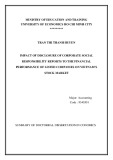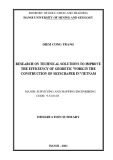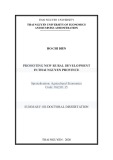1 2
1.3. Research objectives
The overall objective of the thesis: Study the development of microfinance in THE DEVELOPMENT OF MICROFINANCE OPERATION IN VIETNAM CREDIT INSTITUTIONS Chapter 1: Introduction and overview thesisresearch credit activity. The overall objectives are detailed into the following specific
objectives:
(1). Codify the basics of microfinance operations and development
operations of microfinance in credit institutions.
(2). Summary of international experience in developing microfinance
operations of credit institutions, and lessons for Vietnam. 1.1. Necessity of the study Microfinance is one of the characteristic forms of finance for developing countries, focused on the goal of poverty reduction and sustainable development. Approach to microfinance (MF) differs from conventional finance and gets more attention from donors, policy-makers in many countries around the world. (3). Assessment of the situation developing microfinance operations in
Vietnam credit Institutions.
(4). Inspection the relationship between the stability of credit institutions
and the outreach to microfinance in credit institution in Vietnam with
case study Lien Viet Post Join Stock Commercial Bank.
(5). Inspection of the factors affecting the level of customer access to
microfinance operations of Vietnam credit Institutions In Vietnam, Microfinance has developed in recent years, both in terms of legal framework and basic operations. However, the participation of finance institutions providing Microfinance service is low. Microfinance operation in Vietnam Credit institutions is assessed as limited in quantity and poor in quality. Corollary is that many customers can not access to the benefits of microfinance operations, credit institutions are difficult to improve profit.
(6). Proposed a number of recommendations for relevant parties to develop Therefore, the study "The development of Microfinance operation
microfinance operations in Vietnam credit Institutions.
1.4. Research questions
The main research question of the thesis: The decisive factors in
the development of microfinance operations of Vietnam credit
institutions?
This question will be addressed by answering the following specific
questions:
(1). What are concepts and features of microfinance operations in CIs?
(2). What is concept development of microfinance operations in CIs?
(3). What are the assessment criterias developed microfinance operations in CIs?
(4). What are factors affecting the development of microfinance operations in
Vietnam Credit Institutions?
in Vietnam Credit Institutions" is needed. 1.2. Oveview of related studies The process of this thesis follows these issues (i) The concept development of microfinance of organizations providing microfinance services, (ii) Criteria for evaluating the development of microfinance operations, (iii) The relationship between the outreach to microfinance and sustainability of the organization provides, (iv) Developing microfinance operations in credit institutions (Cis), (v) Factors affect the development of microfinance operations. Through the course of the review study found no overall study on the development of indicators to assess microfinance operations of credit institutions and evaluate the factors affecting the development of the microfinance operations of credit institution (CI) combining qualitative and quantitative methods in the perspective of the organization and the customer interest this is the space for this research.
3 4
1.5. Subject and scope of research products and services) and (ii) the depth of outreach (average loan value). 1.5.1. Subject of research
Study subjects of the study is the development of microfinance in credit
institution.
1.5.2. Scope of research
Space of study: Research into the development of microfinance
operations, primarily lending small amounts, of credit institutions.
Time of study: Secondary data on the credit institutions and Lien Viet (3) Applying the model of the relationship between the outreach and sustainability of microfinance institutions of Christen et al (1995), Thys (2000), Olivares-Polanco (2005) as well as the theoretical basis to be suitable to the Vietnamese CIs, the thesis analyzed the proposed model exploring the factors affecting the average loan value with the independent factors: Operating time, sustainability, the breadth of outreach and two additional factors are labor productivity and credit risk (Model 1). Post Join Stock Commercial Bank and elecommunications were collected
during the period 2010-2014.
1.6. Method of research
In the thesis, the author has used a combination of the two methods of
quantitative research and qualitative research, and case studies were typically
Lien Viet Post Join Stock Commercial Bank. The software used was SPSS 20
(4) The thesis adds the factors affecting the development of microfinance in credit activities through the level of customer interest based on consumer behavior theories of Kotler (2001), the trend of choosing credit institutions of Khazeh and Decker (1992), Mokhlis (2009) and proposes model reflecting the dependency relationship between the loan value factors to the level of customer interest to convenience, quality service, brand, price, promotions of CIs and demographic factors (Model 2). and AMOS 20 software. 1.7. New contributions of the thesis 1.7.1. New main theory contributions of the thesis Based on the study of theoretical and practical contributions thesis new
1.7.2. New proposals from the results of the thesis (1) Model 1 showed that the breadth of outreach influence the same way with the depth of outreach and reach different conclusions with findings in models of Olivares - Polanco (2005). Credit risk and labor productivity has affected the same way with depth access. Factors affecting the development of microfinance activities at CIs with decreasing levels as follows: (i) The the breadth of outreach, (ii) Operating time, (iii) Credit risk, (iv) labor productivity and (v) sustainability. academic as follows: (1) The development of microfinance (MF) has been studied mostly in term of social objectives. However, this thesis aims to study the development of microfinance in credit institutions (CIs) as a mean to obtain profit for CIs. This thesis focuses on clarifying the relationship between financial sustainability of CIs and the development of microfinance operations of CIs.
(2) Model 2 showed that the factors affecting the development of the microfinance operations of CIs through the perception of customers with decreasing levels as follows: (i) The convenience of credit institutions, (ii) brand of credit institutions, (iii) quality of service, (iv) price, but promotion has no effect. Additionally, demographic factors such as salary, total income, place of living and education of customer has affected the development of the microfinance credit activities. (2) Based on the indicators to assess the development of microfinance operations in MFIs, the author has selected two groups of indicators to evaluate the development of microfinance in CIs: (1) indicators of financial sustainability include: the profit after tax on average total assets, profit after tax on equity and NPL ratio (2) indicators related to the level of outreach specified by (i) the breadth of outreach (number of customers, size of deposits and loans, number of microfinance
5 6
(3) The thesis put forward two group of recommendations to develop the provision of financial services such as credit, mobilizationpayments, microfinance operations in CIs include: insurance and other services for those with low incomes in society to serve
the needs production, business and investment in order to improve the quality
of customer’s life.
About microfinance customers, the thesis uses the concept of
microfinance clients are directed to credit institutions that includes individual First, for CIs providing microfinance services: (1) Strengthening governance and administration, (2) Design and implement products and services in view of "Customer in the Center "(3) Enhance financial strength (4) strengthen accountability in providing microfinance services; (5) Improve the quality of human resources. customers, small enterprise customers (i) use of financial services on a small
scale, (ii) , primarily low or medium income customers and (iii) that the
demand for loans to focus on the purpose of manufacturing and trading in
order to improve the living conditions. 2.1.1.2. The views of providing microfinance services the Three key theoretical points in providing microfinance are: (i) Traditional Second, for State Bank of Vietnam and concerned agencies: (1) Improve the system guidelines for implementation of the Law on Credit Institutions which have microfinance operations, (2) Expeditiously implement activities within the framework of development strategy for the microfinance sector of Vietnam, (3) create "open conditions" to CIs inspection and in microfinance, (4) Strengthening involved supervision of microfinance operations of credit institutions. with preferential interest rates for credit and concentration; (ii) Ohio with high
interest rates, the direct intervention of the State; (iii) New institutions. The credit
institutions are now focusing apply new institutional perspective to reconcile the
existing problems of the previous two views.
2.1.2. Microfinance operation of credit Institutions 2.1.2.1. Features of the microfinance operations of credit institutions
Unlike microfinance institutions often provide microfinance synthetic
approach, credit institutions mostly minimal approach is to perform financial
intermediation activities. In particular, customers, products and services, 1.8. Structure of the thesis Chapter 1: Introduction and overview thesis research Chapter 2: The rationale for the development of microfinance operation atVietnam credit Institutions Chapter 3: The situation developing microfinance operational of Vietnam credit Institutions Chapter 4: The model and results of research the development of microfinance operation at Vietnam credit Institutions: Case study –Lien Viet Post Join Stock Commercial Bank Chapter 5: Discuss findings and recommendations procedures, requirements of security asset and method of approach differ
Chapter 2: THE LITERATURE REVIEW OF THE DEVELOPMENT from MFIs.. 2.1.2.2. Microfinance operation of credit institutions
OF MICROFINANCE OPERATION N VIETNAM CREDIT Microfinance operations to credit institutions in accordance with
INSTITUTIONS generally minimal approach and implementing financial intermediary role
include the following operations: (i) credit activity, (ii) capital mobilization 2.1. Microfinance operation of Credit Institutions activities, (iii) payment operations, (iv) micro-insurance activity and other 2.1.1. Overview of microfinance operation services. 2.1.1.1. The concept of microfinance operation
About microfinance, using concepts thesis: Microfinance is the
7 8
(i) Breadth of outreach
2.1.3. Credit institutions providing microfinance services 2.1.3.1. Definition and classification of credit institutions
The types of credit institutions provide formal SCM area include: (i)
Development Bank, (ii) Savings bank and Postal saving bank, (iii) Commercial Breadth of outreach of credit institution is the level of access to customers across the board, to be assessed through the diversification of supply of products and services; the level of customer growth, the outstanding loans and deposit balances.
(ii) Depth of outreach for credit institutions to develop
banks, ( iv) The credit institutions non-bank. 2.1.3.2. Fundamental principles microfinance operations
Ledgerwood (1999) provides 12 fundamental principles that credit
institutions must follow if they choose to focus activities on microfinance
client groups, including some specific principles of microfinance as universal
figure out what services customers really necessary, establish appropriate With depth indicators reach an average loan value mean the total average loan balance divided by the number of borrowers (Woller and Schreiner, 2000). This thesis in due consideration of a country, can simply average loan size. The lower this value indicates is a level deeper of outreach of credit institution. 2.2.3.2. Sustainability For credit institutions, two forms of distribution, cover the cost of the loan interest rate reasonably
positive.
2.2. Developing microfinance operations of credit institutions
2.2.1. Concept of development of microfinance operations
In the thesis the development point of credit institutions operations
focused on the perspective of credit institutions are: increase access to indicators of financial there are sustainability that we can observe in assessing the effectiveness of the credit institution's return on total assets (ROA) reflect the ability organizations to develop productive assets and for organizations sponsoring the return on equity (ROE), which measure the return of investment of the owner. 2.2.3.3. The relationship between the outreach and sustainability of the credit institutions microfinance clients and ensure the financial sustainability of the credit
institutions.
2.2.2. The indicator assessing the development of microfinance
operation
With the objective of the thesis, indicators on outreach and
sustainability are used to measure the development of microfinance operation The issues of Outreach and sustainability issues and has close relation. Sustainability is the basis for expanding access to credit, and to expand access, then credit institutios can then be capable to ensure financial sustainability. 2.2.3.4. The ratio of overdue debt / total loans and bad debt / total loans 2.3. Factors affecting the development of the microfinance operations of credit institutions The sustainabilityand outreach of of credit institutions. 2.2.3.1. Outreach
Indicator of outreach is measured through two angles: the breadth and
microfinance the operationsofcreditinstitutions depends on many factors, which are divided into two groups: internal factors and external factors. 2.3.1. Factors belong to credit institutions depth of the outreach. Depth of outreach refers to the average lending rates of
microfinance clients are served, while the breadth of outreach refers to the
number of clients target of credit institution.
(i) Development strategy and business plan implementation strategies, (ii) Owned properties and operational model, (iii) the potential finance of credit institutions, (iv) Products and Services navigate to microfinance clients, (v) Network of credit institutions, (vi) Human resources of credit
9 10
Development Strategy in 2011-2020 (Decision No. 2195 / QD-TTg of the Prime Minister dated 26/12/2011). 3.1.3. Development status of microfinance operations of Vietnam credit Institutions
institutions, (vii) Risk management capacity (viii) The infrastructure of information technology. 2.3.2. Factors belong to environment (i) The regulatory environment, (ii) Economic and society environment. 2.4. International experiences and lessons for Vietnam to develope microfinance operations in credit Institutions
Currently the major Vietnam credit institutions with microfinance operations include Vietnam Bank for social policies, Co-operative Bank of Vietnam and system Central People's Credit Funds, MFIs and commercial banks typically Agribank. - Vietnam Bank for Social Policies (VBSP) has the largest market share, with the best outreach in the main credit provider.
- Co-opbank and PCFs system and impressive growth in the period 2012-
From the successful experience in the development of microfinance operations of credit institutions in the world, three lessons for Vietnam credit institutions as follows: (i) Improving the regulatory environment for institutions, (ii) Select appropriate microfinance operations of credit operational model for Vietnam credit Institutions, (iii) Design various products and services, consistent target customer needs. Chapter 3: THE SITUATION OF DEVELOPING MICROFINANCE OPERATION OF VIETNAM CREDIT INSTITUTIONS 2014, with outstanding loans increased from $ 1 billion to $ 1.78 billion - MFIs have very good depth of outreach but not reach good breadth and not achieve sustainability with three new organizations formalized (TYM, M7 and MFI Thanh Hoa).
Vietnam Credit
3.1. Overview of the microfinance operations of Institutions 3.1.1. Economic environment
- Agribank has a total size of the largest operations in agriculture and rural areas.However the number of borrowers and saving customers, microfinance loans behind the VSPB, Co-opbank and PCFs systems, the development of microfinance operations in Agribank is assessed through outreach and sustainable criterias: Outreach Breadth of outreach Advantage: The highest professionalization level compared with other units on the microfinance market with (i) product diversification, the development potential of modern banking services compared to other banks; (Iii) attract many different types of customers.
Disadvantage: Is not "friendly" to customers with poor and low-income loans are usually large-scale, complex procedures and high demands on security assets. Vietnam is a very potential market for microfinance services, has about 60 million people (more than 70% of the population) reside in rural areas and 24.4 million people (about 67% of the workforce at a young age and mature) (GSO, 2014 (cited in OECD, 2015)). The 02 decades GDP per capita actual up to three times. Along with the economic development of the country, rural areas are being converted quickly. Demand for capital and financial services for the development of agriculture and the rural economy in general and families in particular are huge. Although Vietnam has a system of microfinance service providers is quite powerful but still not enough to meet the needs of microfinance, especially only a few banks offer microfinance services 3.1.2. Regulatory environment
It is the first time in history, Microfinance was regarded as a kind of formal credit institutions, the central bank is managed according to Law No. is oriented Microfinance Sector 47/2010 dated 16.06.2010, which Depth of outreach Agribank selection focuses on the upper market segment, customers are worth relatively big loans and they often have above-average incomes than the living.
11 12
Sustainability
to obtain
Internet banking activity
lending process included: Process standard lending products and lending procedures quickly, (5) Design and deploy the product. Mobilization activity LienVietPostBank focusing on customer deposits low-cost financing through not only stable branch network, but also a series of postal system. Payment Activity Lienviet PotsBank offers a full range of services from international/domestic payment LienVietPostBankis providing modern banking services such as SMS Banking, Mobile Banking and Internet Banking, specialy new product has name ViViet that will help LienVietPostBank to develop microfinance operations. Micro-Insurance activity Microfinance services are extended is combined insurance services - banking. 3.2.2.2. Assessing the outreach of microfinance
Mobilization and loans are extended and strong growth after the merger, With the advantage of sustainability banks should operate better Agribank main credit institutions providing services microfinance but financial sustainability and institutional sustainability was ensured. The ratio of bad debt and bad debt balance at a high level compared with other credit institutions. 3.2. Developing microfinance operation of Lien Viet Post Join Stock Commercial Bank 3.2.1. Overview of Lien Viet Post Join Stock Commercial Bank 3.2.1.1. Introduction of Lien Viet Post Join Stock Commercial Bank 3.2.1.2. The suitability of building microfinance operation in Lien Viet Post Join Stock Commercial Lien Viet Post Join Stock Commercial Bank has the opportunity to develop microfinance operations in Vietnam as this is a potential market on the basis LienVietPostBank are eligible for deployment of microfinance its advantages through operational network nationwide covering all areas even remote regions. 3.2.1.3. The main business results of Lien Viet Post Join Stock Commercial Bank the level of access is increasing in both width and depth. a. Breadth of outreach
Growth of customer quantity, outstanding loans and savings balances
For micro mobilization most indices when compared three times in 2014 with the period before the merger (in 2010). these Through After 7 years of operation, the total pre-tax profit of nearly 5,000 billionLienVietPostBank, averaging more than 700 billion / year, a dividend payout ratio of cash to be maintained and guaranteed annual average at 10 - 15 years. 3.2.1.4. Social activity of Lien Viet Post Join Stock Commercial Bank operations practical have
For lending activity, the highlights were deployed lending activity on postal channels, which before the merger unmatched since 2014 and provides additional micro loan product, the number of borrowers and loans reached significant results. Diversity of provided services b. Depth of outreach
significance; LienVietPostBank unit is one of the leading social charity activities in Vietnam. 3.2.2. Development status of microfinance operation of Lien Viet Post Join Stock Commercial Bank 3.2.2.1. Microfinance operation The detailed orientation and adequate building of Lending activity (1) Eligible customers are customers of Microfinance, (2) Business risk management is focused, (3) Various distribution channels, (4) Specific In 2014, LienVietPostBank has furthered the micro-credit operations with loans less than 50 million and growing deeper approach. But profit of LienVietPostBank still mainly from lending activity, followed by the
13 14
b. Financial sustainability of the banks is not guaranteed The financial performance of all credit institutions are very low, with the average ROA are below the international practice is 1%. 3.2.2. Causes
mobilization of capital, other activities still account for only a low proportion of total income. 3.2.2.3. Assessing the sustainability of microfinance a. Institutional sustainability (ISS) Achieving institutional sustainability under four basic criteria standards recommended by the organization Planetfinance (cited in Nguyen Kim Anh and Le Thanh Tam et al, 2013): b. Financial sustainability (ROA, ROE)
ROE and ROA reached respectively 7.72% and 0.78% in 2013 to reach 6.36% and 0.53% in 2014. On average ROA and ROE of LienVietPostBank have a much higher rate than the average of the industry. b. NPL ratio
for combination with results Chapter 4
At 31/12/2014, the NPL ratio of LienVietPostBank is 1.23% with reduction 1.25% compared with 2013. Compared with other commercial banks, and compared with the standard rate of Moody's and safety frames CAMEL 2%, LienVietPostBank has low NPL ratio. 3.3. Assessing the situation of microfinance operation development in the Vietnam credit institutions 3.3.1. The achieved results (i) Credit institutions perform microfinance operations achieved good breadth of outreach. (ii) Credit institutions implementing microfinance operations increasingly deeper approach. (iii) The sustainability of these credit institutions to implement microfinance operations is gradually being improved. 3.3.2. Limit and causes 3.3.2.1. Limit a. Outreach levels (i) The number of products and services has not varied, plentiful and there are only very few credit institutions design products microfinance. (ii) Number of customers and scale of microfinance services remains low. In addition to the subjective reasons such as: (i) Development Strategy have not yet been specifically and properly invested, (ii) Operational model is not complete, (iii) The financial capacity is limited, (iv ) Not focus / interest in the development of products and services for microfinance clients, (v) The majority of credit institutions is limited to network operations (vi) Lack of human resources quantity and low in quality, (vii) Awareness of risk management activities is limited / incomplete, (viii) The infrastructure of information technology has not met and no financial database micro credit organizations; The objective causes need to be identified: incomplete legal framework and economic environment and the society does not yet support also plays an important role in the cause of limited development of microfinance operations in Vietnam credit institutions. These causes are the basis to make research recommendations for the development of microfinance operations in the credit institutions in chapter 5. Chapter 4: THE MODEL AND OF RESEARCH RESULTS OF THE THESIS: « DEVELOPMENT OF MICROFINANCE OPERATION AT VIETNAM CREDIT INSTITUTIONS » CASE STUDY –LIEN VIET POST JOIN STOCK COMMERCIAL BANK 4.1. Researching model and hypotheses 4.1.1. Research model Base on the model by Christen (1995) and Thys (2000) and Olivares-Polanco (2005), this thesis has some adjusted to make it suitable to Vietnam credit institutions: Model 1 analysis of the factors influencing directly to the average value of loans in Credit institutions. Model 2 analysisof the factors influencing the value of loans in Credit
15 16
Items Content theories Cited establishments
institutions through the level of interest of microfinance clients. 4.1.2. The research hypothesis 4.1.2.1. Group hypothesis of Model 1
H9 The level of customer interest for prices affect the value of customer loans Items Table 4.1: The hypothesis of the model 1 Content theories
H10 The level of customer interest for of value the (1999), Kotler Ledgerwood (2004); Khazeh & Decker (1992); Yavas et al (2009), Mokhlis (2009) Kotler (2000); Keller (2001); Mokhlis (2009) affect brands customer’s loans H1 Uptime of the organization (Age) has a postive impact on the value of average loans (ALB) sustainability H2 The of Kotler (2004)
Cited establishments Kristen et al (1995), Olivares- Polanco (2005), Cull et al (2007) Ledgerwood (1999), Christen et al (1995), Olivares-Polanco (2005), Cull et al (2007) H11 The level of customer interest for the promotional affect the value of customer’s loans the organization (SUS) has a postive impact the value of average loans (ALB) Table 4.3: The hypothesis of the demographic factors of the model 2 H3 Wide approach Schreiner (2001)
Items Content theories Cited establishments (NOB) has a negative impact on the value of average loans (ALB) H12 Place of life has affect the value of the loans at creditinstitution of customer H4 Labour productivity (LP) has a negative impact on the average loan value (ALB) H13 Salary of customer has affect the value of the loans at creditinstitutionof customer H14 The total income of customer has affect the value of Network and the loans at credit institutionof customer SEEP Network and Calf Meadow (1995), TAP (1997), Yaron, Benjamin, and Piprek (1997), Waterfield and Rasming (1998) SEEP Calmeadow (1995) Porsche Von (1991) (cited in Ledgerwood, 1999). H15 Educational attainment of customer has affect the H5 Credit risk (Risk) has a negative impact on the average loan value (ALB) value of the loans at credit institution of customer Von Poschle (1991) H16 Customer's gender has affect the value of the loan at
credit institutions of customer the factors that the development of H6 There are differences between the credit institutions have different areas of the average value of credit loans
4.1.2.2. Group hypothesis of Model 2 4.2. Analyzing influence microfinance operations in LienVietPostBank. 4.2.1. The researching sample and data Table 4.2: The hypothesis of the model 2 To evaluate the activity development of Microfinance in case studies Items Content theories Cited establishments
of LienVietPostBank with form the branches of the bank. 4.2.1.1. The researching sample and data of model 1
The data obtained in the fiscal year period: In 2013 and 2014. The H7 The level of customer interest for the convenience affect the value of customer loans number of observations is 129 observers included 57 observers in 2013 and
72 observations in 2014. The data set includes data business performance H8 The level of customer interest in the quality of services affects the value of customer loans Kotler (2004); Khazeh& Decker (1992); Yavas et al (2009), Mokhlis (2009) Khazeh & Decker (1992); Yavas et al (2009), Mokhlis (2009) represents sustainability can be measured and appropriate depth of outreach
to research. 4.2.1.2. The researching sample and data of model 2
17 18
The sample of this study is 1.000 clients of the transaction on the
network of LienVietPostBank. A number of people interviewed intend to
lend and borrow are 269 people (158 people who have loans and 111 people customer loans. Conversely the level of customer interest in promotion does not affect the value of customer loans. 4.2.3.2. Conformity assessment and analysis of the relationship between between demographic factors to the value of customer’s loans who have loans intended).
4.2.2. Assess the suitability of the model 1 and analyze the relationship
The index assessing the models showed good assessment model very well and fully consistent with the observed data, reflect the change and the way the impact of the observed variables. between the observed variables in the model 1 4.2.2.1. Assess the suitability of model 1 Result of analysis The index assessing the models showed good assessment model very 5% With level, significance development the
well and fully consistent with the observed data, reflect the change and the
way the impact of the observed variables. 4.2.2.2. Analyse the relationship between the observed variables in Model 1
Results weighted regression tables are not standardized, with the Sig of microfinanceoperations at credit institutions also affected the demographic factors including wage factor, the total income of the customer, where the living and educational level of customers, but not affected by the gender of the customer, this also shows the difference compared to many MFIs worldwide selection microfinance customers are mainly women. pvalue value <0.05 shows the relationship between these factors have
significantly with 95% reliability.
To answer H6, we used analysis of variance ANOVA for statistical analysis
techniques to analyze. Results: With Sig value = 0.007 <0.05 show that 95%
reliability, with the difference in the average loan value between credit
institutions in the region/different localities.
4.2.3. Assess the suitability of the model and analyze the relationships
thesis has drawn definiation and characteristics of In summary, the results of the study showed that out of 16 hypotheses posed, only 2 hypotheses are rejected and 14 accepted hypothesis. The results are largely in line with the overall theory and research work related and consistent with the actual operation of microfinance in Vietnam Credit Institutions. Chapter 5: DISCUSS FINDINGS AND RECOMMENDATIONS 5.1. Finding Based on the study of theory and practice, the thesis has the main results through answering the following research questions: 5.1.1. The microfinance operations of credit institutions between the observed variables in the model 2 4.2.3.1. Conformity assessment and analysis of the factors affecting the value of customer’s loans in credit institutions through the level of customer interest in convenience, service quality, brand, price and promotion. 5.1.1.1 The notion of microfinance operations
Microfinance operations in credit institutions in accordance with
generally minimal approach and implementing financial intermediary role The index assessing the models showed good assessment model very well and fully consistent with the observed data, reflect the change and the way the impact of the observed variables.
include the following operations: lending, deposit operations, payment
operations and electronic banking, micro-insurance operations and other
Result of analysis Based on data of analysis, P - value for the test results to know the relation between the variables in the research model: The level of customer interest in convenience, brand, service quality and prices that affect the value of
services. 5.1.1.2. Characteristic of microfinance operations in credit institutions - Customers: Middle-income customers, rather, both rural and urban, In
19 20
- Breadth of outreach represent factors (i) products and services oriented to microfinance clients, (ii) of the CI network, (viii) infrastructure to support information technology. addition to individual clients, small business, there are organizations and small enterprises, micro and private state are often capable of collateral, there is a need for larger loans for production development, business expansion or construction works, irrigation systems, bridges ... - Assets secured: Unsecured or collateral. In case of unsecured loans,
higher lending rates and smaller loan / grant higher appraisal. - Products and services: diversified but only few organizations specifically - Vietnam Credit Intistutions sustainability of these factors represents (i) development strategy and business plan implementation strategies, (ii) Owned properties and organizational model, (iii) The potential finance of the credit institution.
designed for microfinance clients. - Labor productivity represents the human resources element of the Vietnam Credit institutions. - Credit risk represents the capacity factor of credit risk management.
- Processes and procedures: more complicated. - Approach: At branch / credit transactions. 5.1.2. The thesis draws the concept development of microfinance operations in Vietnam Credit Institutions and the analysis of the relationship between sustainability factors and reaches a depth of outreach factor
Quantitative research confirms: According to research results of model 1 in chapter 4, the decisive factor directly to the development of microfinance activities of credit institutions with diminishing (which adds uptime factor of the organization) as follows: (i) The breadth of outreach, (ii) Duration of organized operations, (iii) Credit risk, (iv) Labor productivity.
According to research results of model 2 in Chapter 4, add the factors affecting the development of microfinance activities of credit institutions through the perception of microfinance clients with decreasing levels as follows: (i) The advantage of a credit institution, (ii) Brand of the organization, (iii) quality of service, (iv) the prices of products and services.
factors affecting testing and the In the thesis the concept development of the microfinance credit activity focus on aspects of credit institutions are: increase access to microfinance client’s andensure financial sustainability of the Vietnam Credit Institutions. 5.1.3. The thesis option and adjust the indicators to assess the development of microfinance operations in microfinance institutions into two groups of indicators to assess the development of microfinance operations in Vietnam Credit Institutions 5.1.4. Recommend additional development of microfinance operations of Vietnam Credit Institutions Sustainability levels of credit access depend on many factors, which
are divided into two groups: internal factors and external factors.
Factors belongs credit institutions include: (i) development strategy and business plan implementation strategies, (ii) Owned properties and organizational model, (iii) The potential finance of credit institutions, (iv) products and services oriented to microfinance clients, (v) network of credit institutions, (vi) human resources of credit institutions, (vii) risk management capacity. (Viii) The infrastructure of information technology. Besides, the development of microfinance in credit activity also affected the demographic factors including wage factor, the total income of the customer, where the lives and education of customers but unaffected motivated by the gender of the customer. 5.2. Development oriented microfinance operations in the VietnamCredit institutions 5.3. Recommendations aimed at developing microfinanceoperations of Vietnam Credit institutions 5.3.1. Recommendations with Vietnam creit institutions 5.3.1.1. Strengthening governance and administration Reasons of recommendations:
Quantitative research in chapter 4 was conducted to confirm and complement the findings with the variables in the research model as follows: Microfinance operations of Vietnamcredit institutions development to what extent and according to the schedule depends entirely on the
21 22
perception of the Board / Council members, the Executive Board and the entire staff of that credit.
to Unit the recommendation: The VietnamCredit
5.3.1.4. Enhancing accountability in providing microfinance services Reasons of recommendations: In order to increase the level of access and institutional sustainability Unit to implement the recommendation: The Credit institutions want to develop microfinance operations Mode of implementation of the recommendations:
Identify recommendation: specific operational model of
Make sure all the terms of loans and deposits, customers are known and are clearly explained. Should carry out regular independent audit of the financial statements in order to increase the transparency of the organization, from which the reputation of credit institutions is built and strengthened. 5.3.1.5. Improving the quality of human resources Reasons of recommendations: In order to increase accessibility and sustainability Unit to implement the recommendation: The credit institutions want to develop microfinance operations Mode of implementation of the recommendations:
As one of the key solutions to developing long-term and sustainable operation of Vietnamese credit institutions Nam.Vi Thus, the development of human resources mainly through the development of infrastructure for professional training and management play a very important role. 5.3.2. Recommendations for State Bank and the competent authorities 5.3.2.1. Complete guidelines system under the Law for the credit institutions with microfinance operations Reasons of recommendations: In order to increase accessibility and sustainability Unit to implement the recommendation: State Bank of Vietnam, MOF Mode of implementation of the recommendations:
To develop and apply the indirect management tools, to ensure the general safety for the microfinance credit operations should consider international practices and operational characteristics of these organizations when making regulations on capital adequacy ratio minimum, credit policy, loan classification and provisioning of credit risks, the establishment and expansion of branches. implement institutions to develop microfinance operations Modes of implementing key recommendations: (i) Development of strategy and clear operational plan; (ii) Identify the specific model of microfinance operations, (iii) Develop mechanisms of control, internal audit, effective operating organization to ensure safe operation and healthy. Priority microfinance in Vietnam credit institutions. 5.3.1.2. Design and deployment of products and services in view of "Customer is center" Reasons to implement the recommendation: In order to increase the level of access Unit to implement the recommendation: The Credit institutions want to develop microfinance operations Mode of implementation of the recommendations: For official credit institutions, should enhance savings mobilization populated with different ways to mobilize and diversify capital mobilization forms with different interest rates. Strengthening investment in non-financial services to meet the needs of society capacity building of our customers, because this is the biggest difference of microfinance credit institutions and service providers to other credit institutions. 5.3.1.3. Enhance financial strength Reasons of recommendations: In order to increase the level of access Unit to implement the recommendation: The Credit institutions want to develop microfinance operations Mode of implementation of the recommendations: The credit institutions can increase financial resources through: (1) Applying the management system works well, (2) Use of technology to reduce costs, (3) Expand the width to reduce costs of 1 loan contract, Reduced costs of credit institutions raising capital through attracting investors to the domestic and international markets; The early issue and released the guidelines under the Act and the tax
23 24
Thirdly, survey data sources customers are taken on the investigation results of the Bank advice Poste Postal Union Bank of Vietnam should just stop over 10 provinces and cities have developed promising microfinance.
incentives and favorable conditions for the microfinance industry to participate in the formal financial market. 5.3.2.2. To expeditiously implement operations in the framework of the microfinance sector development strategy Vietnam Reasons of recommendations: In order to increase the level of access. Unit to implement the recommendation: The State bank of Vietnam Mode of implementation of the recommendations:
In this thesis, the author has pointed out the factors that influence the development of microfinance operations in Vietnam credit institutions, the relationship between sustainability and the level of access in the course of development financing operations micro-credit institutions. If previously the microfinance concept only affects the microfinance clients in the next research orientation, when the participating credit institutions deeper into the microfinance market, the author hopes to study (1) the impact of results microfinance operations to target the profits of credit institutions and (2) the difference between credit institutions and microfinance credit institutions not to target microfinance operations profit and social responsibility.
Besides the issuance of guidance documents under the Law, the State Bank management should urgently deploy industry operations sector development strategy was approved by the Prime Minister. 5.3.2.3. Facilitate "open" for credit institutions engaged in microfinance Reasons of recommendations: In order to increase accessibility and sustainability Unit to implement the recommendation: The State bank of Vietnam Mode of implementation of the recommendations:
CONCLUDE The thesis’s has overview of and systematization of the rationale for the development of microfinance operations in credit institutions. There by focusing in-depth analysis of the organizational perspective to see the primary role of microfinance operations to target the profits of the credit institution under study.
The thesis option and adjust the indicators to assess the development of microfinance operations in MFIs assessment criteria developed microfinance operations in Vietnam fiancial institution.
The permission for
Encourage the participation of many organizations in the microfinance sector, especially commercial banks have potential microfinance market participants. 5.3.2.4. Strengthen inspection and supervision of microfinance operations of Vietnam Credit Institutions Reasons of recommendations:In order to increase the depth reached through capacity building and risk management and increased breadth of outreach. Unit to implement the recommendation: State Bank of Vietnam Mode of implementation of the recommendations: the establishment of microfinance credit institutions will set for the State management agencies, especially the central bank needs to solve problems such as inspections, monitoring, licensing, and change of policy mechanisms... 5.4. Limitations of thesis and subsequent research orientation
The thesis draws that credit institutions offer microfinance services can balance the level of access and participation for sustainable microfinance market - one of the largest markets in the world is still open, if participation, credit institutions will create a strong competitive advantage in the coming decades. There are certain guidelines for credit institutions to develop microfinance operations and based on the degree of influence of the factors proposed in the thesis, the Vietnam Finance Intistutions should be selected in order of priority recommendations for development microfinance operations based on organizational resources.
First, when researching all the commercial banks, difficult separately Crawls microfinance component of joint operations of credit institutions to assess sustainability. But the ultimate goal is to achieve sustainability for the organization should share the results may reflect meet study objectives. Secondly, the level of institutional self-sustainability is not quantified.

